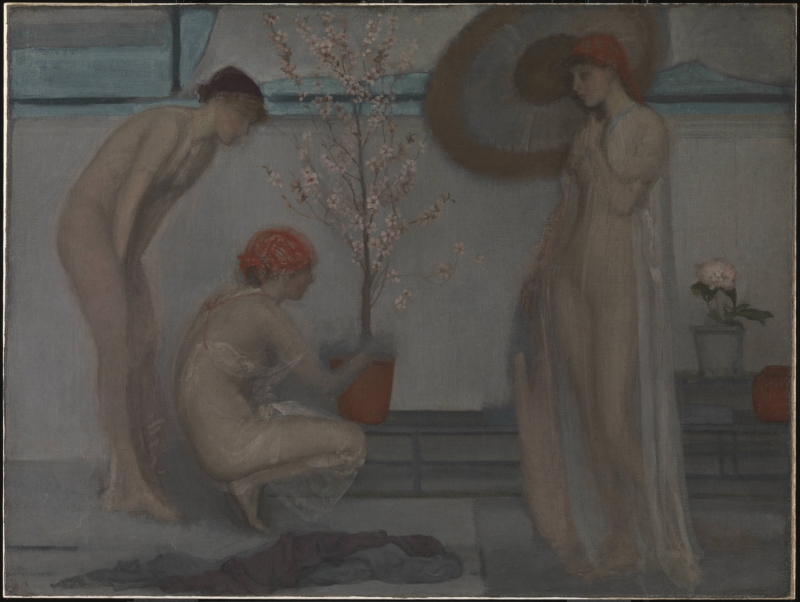Home > Catalogue > Browse > Pink and Grey: Three Figures << >>
Titles
Basically one title has been suggested, with the word order varying:
- 'Three Figures, pink and grey' (1892, Goupil). 1
- 'Three Figures, pink and grey' (1905, ISSPG). 2
- 'Pink and Grey: Three Figures' (1980, YMSM). 3
'Pink and Grey: Three Figures' is the preferred version.
Description
A figure composition in horizontal format, showing three women in diaphanous white robes in a garden or conservatory. The woman at left stands bending forward to right,with her hands on her knees. The woman in the centre crouches facing to right, with her arms reaching out to a flowering cherry tree in an orange pot sitting on a low table. At far right there is a blue and white vase with a pink flower. The woman at right, facing left, wears a red headband or scarf; her left arm crosses her body, holding a large parasol with red edging over her right shoulder. Behind them is a white shoulder-high fence. Awnings or blinds hang on a blue open framework visible above the fence, against a blue sky. A rug and a dark blue robe lie on the white floor.
Sitter
Unknown.
Comments
Frances Fowle comments:
'This picture derives from one of six oil sketches that Whistler produced in 1868 as part of a plan for a frieze, commissioned by the businessman F.R. Leyland (1831-92), founder of the Leyland shipping line. Known as the 'Six Projects', the sketches … were strongly influenced by his admiration for Japanese art. Another precedent for these works was The Story of St George, a frieze that Edward Burne-Jones (1833-98) executed for the artist and illustrator Myles Birket Foster (1825-99) in 1865-7. ...
Although the three figures are clearly engaged in tending a flowering cherry tree, Whistler's aim in this picture is to create a mood or atmosphere, rather than to suggest any kind of theme. Parallels have been drawn with the work of Albert Moore, whose work of this period is equally devoid of narrative meaning. The design is economical and the picture space is partitioned like a Japanese interior. The shallow, frieze-like arrangement, the blossoming plant and the right-hand figure's parasol are also signs of deliberate Japonisme. ... It has been suggested that Whistler derived his colour schemes, and even the figures themselves, in their rhythmically flowing drapery, from polychrome Tanagra figures in the British Museum, which was opposite his studio in Great Russell Street.' 4
Notes:
1: Nocturnes, Marines & Chevalet Pieces, Goupil Gallery, London, 1892 (cat. no. 399).
2: Memorial Exhibition of the Works of the late James McNeill Whistler, First President of The International Society of Sculptors, Painters and Gravers, New Gallery, Regent Street, London, 1905 (cat. no. 399).
Last updated: 25th November 2020 by Margaret






